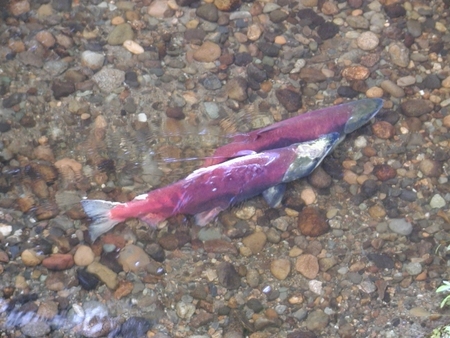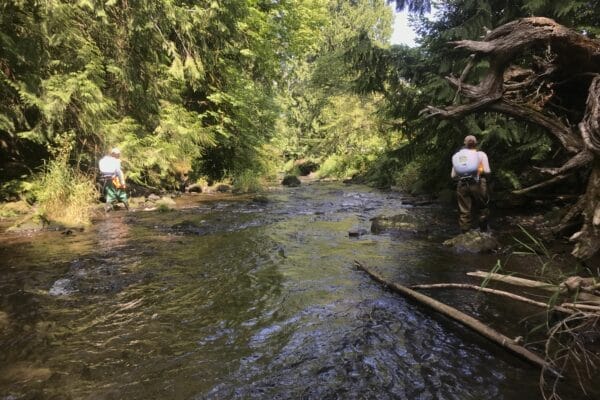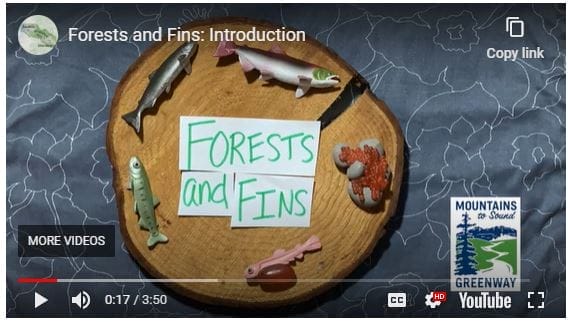Salmon SEEson in the Greenway
Information from King County Salmon SEEson Press Release
Pacific salmon – including sockeye, Chinook, coho, pink, and chum – have begun the journey from the open ocean to their birthplaces to spawn in streams and rivers that feed into Puget Sound. Lake Sammamish kokanee, which are landlocked sockeye salmon that spend their entire lives in freshwater, will soon move into streams feeding the lake to spawn.
The Salmon SEEson program helps people witness these amazing migrations at locations around King County.
Find self-guided viewing locations as well as virtual viewing opportunities on the Salmon SEEson website. If you decide to visit a self-guided site, please remember to follow current public health guidelines and plan ahead: Practice physical distancing, wear a mask, choose a site near you, leave no trace, and contribute to an inclusive experience for all.
These salmon-viewing locations offer the best chances of seeing salmon – particularly during a year when many stocks are returning in below-average numbers.
Each year, the Muckleshoot Indian Tribe and Washington Department of Fish and Wildlife count numbers of salmon returning through the Ballard Locks fish ladder from mid-June to early October. Sockeye typically migrate through the Ballard Locks from May to August, followed by Chinook from July to September, and coho from late August to November.

In recent years, sockeye numbers have declined substantially in the watershed. Chinook returns remain well below population recovery goals. Lake Sammamish’s native kokanee population has been in decline for the last few decades, and King County and partners continue to take actions to avoid possible extinction.
Salmon are sensitive to the changing climate, including warming lake and stream temperatures. Warmer water stresses salmon and can increase salmon susceptibility to disease and increase predator metabolism and consumption of juveniles as they migrate out to saltwater in Puget Sound.
Salmon are a Pacific Northwest icon and a vital cultural, economic, and environmental resource for our region. Local governments and community groups around King County and Puget Sound are working to recover salmon populations by protecting and restoring habitat, managing stormwater runoff from streets and other hard surfaces, and educating the public about what they can do to help.
Working to recover salmon is about more than salmon – it is fundamentally about caring for our home and making our communities sustainable for the long-term. Protecting and restoring salmon habitat also improves water quality, reduces flood hazards, protects open space, improves stormwater management, sustains and improves our quality of life, and promotes a proud legacy of stewardship for future generations. Practicing water conservation and pollution prevention year-round helps salmon thrive, which means more fish can survive and continue their journey to the ocean and back to local streams and rivers.
Salmon SEEson is sponsored by the WRIA 8 Salmon Recovery Council as part of its effort to recover salmon in the Lake Washington/Cedar/Sammamish Watershed. Additional sponsors include the Saving Water Partnership, Duwamish Alive Coalition, the Green/Duwamish and Central Puget Sound Watershed, the Snoqualmie Watershed Forum, and King County. For more information, visit kingcounty.gov/see-salmon-safely.
Salmon Viewing in Kittitas County
While the Salmon SEEson program is focused on King County, those living in, or visiting, the east side of the Mountains to Sound Greenway can see sockeye spawning at the Cooper Bridge. Head north on Highway 903 out of Cle Elum – the road will eventually turn into Salmon La Sac Road. Take a left at the NF-46 road toward Cooper Lake. There is parking on either side of the road, and if necessary, on the other side of the bridge. You can look on either side of the bridge to see the sockeye spawning. Please be respectful of these fish as you watch and do not throw rocks or enter the water. They are already stressed as is and need to use all their energy safeguarding the next generation of salmon.
Can’t get out, or happen to miss the salmon in person? Check out this incredible video shared by the Kittitas Conservation Trust!
How Our Restoration Work Is Helping Salmon

For almost 20 years, the Mountains to Sound Greenway Trust has worked to restore the riparian buffer – the ribbon of land that runs alongside creeks and streams – of Issaquah Creek and other salmon bearing streams. Issaquah Creek starts with headwaters and tributaries in the Issaquah Alps flowing 13 miles to empty into Lake Sammamish. The creek is host to Chinook, coho, and sockeye salmon, and has been identified as a critical spawning ground for salmonid species. The Greenway Trust’s work focuses on replacing invasive species like Himalayan blackberry, English ivy, and Bohemian knotweed with native coniferous plants like Douglas fir and Western red cedar. These reintroductions bring with them a myriad of ecological benefits. (read more)
Expand Your Family’s Salmon Knowledge With Our Virtual Education Resources
You may not be able to get out on Greenway Education Program field trips right now, but that doesn’t mean you have to stop learning about the natural world. Check out our Virtual Education web page, where you’ll find a variety of lessons, at-home activities, and can even go on a virtual field trip. Engage with our curriculum, then head out to one of the many viewing locations on the Salmon SEEson website to really bring the lesson to life! We’d love to see what you’re up to, so consider snapping a photo and tag the Mountains to Sound Greenway on Facebook, Instagram, or Twitter and use #GetOutAndGreenway.






